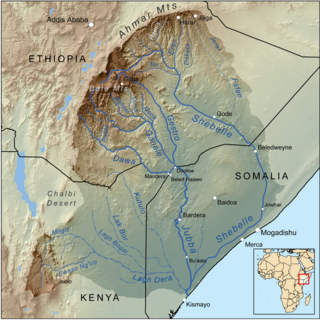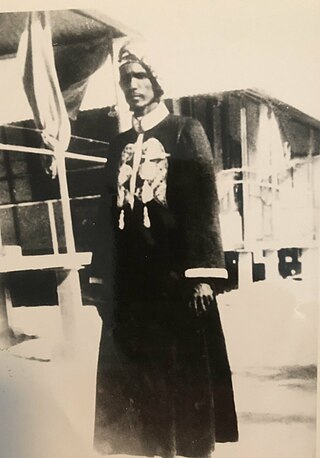| Yarrow Maaytey | |
|---|---|
| 1st Sultan of the Galluweger Dynasty | |
| Reign | 17th century |
| Predecessor | n/a |
| Successor | Amir Geedow |
| Dynasty | Galluweger Dynasty |
| Religion | Islam |
Yarrow Maaytey was a Somali ruler, and the founder of the Galluweger Dynasty.
| Yarrow Maaytey | |
|---|---|
| 1st Sultan of the Galluweger Dynasty | |
| Reign | 17th century |
| Predecessor | n/a |
| Successor | Amir Geedow |
| Dynasty | Galluweger Dynasty |
| Religion | Islam |
Yarrow Maaytey was a Somali ruler, and the founder of the Galluweger Dynasty.
Sometime in the 17th century, about 12,000 members of the Galluweger tribe, under the leadership of Yaroow Maaytey, fought against the armies of the Ajuran Dynasty. Yaroow Maaytey becomes the first Galluweger Dynasty to rule outside the Bakool region. His son Amir Geedow would later succeed him. Although both his reign and empire were short-lived, the cultural impact of his conquests lasted for centuries. He had brought most of the city-state concept in Somalia and united all Maay speaking people Digil & Marifle using both military and diplomatic means. Shiek Yarow Maaytey repeatedly defeated the Ajuran army in battle; marched through what is now known Bakool, Bay, and Afgooye where he defeated the Silcis Dynasty, Bardheere (Geedo region) in the process he overthrew the Ajuuraan king and conquered half the entirety of the Ajuran Empire.
Somalia, officially the Federal Republic of Somalia and formerly known as the Somali Democratic Republic, is a country located in the Horn of Africa. The country was an important centre for commerce with the rest of the ancient world, and according to most scholars, it is among the most probable locations of the fabled ancient Land of Punt. During the Middle Ages, several powerful Somali states and port towns dominated the regional trade, the Mogadishu Sultanate and Ajuran Sultanate both centered around the port town Mogadishu, but also the port towns of Barawe and Merca.

The Horn of Africa (HoA), also known as the Somali Peninsula, is a large peninsula and geopolitical region in East Africa. Located on the easternmost part of the African mainland, it is the fourth largest peninsula in the world. It is composed of Ethiopia, Eritrea, Somalia and Djibouti; broader definitions also include parts or all of Kenya, Sudan, South Sudan, and Uganda. The term Greater Horn Region (GHR) can additionally include Burundi, Rwanda, and Tanzania. It lies along the southern boundary of the Red Sea and extends hundreds of kilometres into the Guardafui Channel, Gulf of Aden, and Indian Ocean and shares a maritime border with the Arabian Peninsula of Western Asia.

The Jubba River or Juba River is a river in southern Somalia which flows through the autonomous region of Jubaland. It begins at the border with Ethiopia, where the Dawa and Ganale Dorya rivers meet, and flows directly south to the Somali Sea, where it empties at the Goobweyn juncture. The Jubba basin covers an area of 749,000 km2 (289,000 sq mi). The Somali regional state of Jubaland, formerly called Trans-Juba, is named after the river.
Baidoa is the largest city of the South West State of Somalia.
The Ajuran is a Somali clan, part of the Jambelle clan which itself belongs to the largest Somali clan-family — the Hawiye. Ajuran members largely inhabit Kenya as well as southern east Ethiopia; considerable numbers are also found in southern Somalia. Some Ajuran members settled in Mogadishu.

The Hawiye is the largest Somali clan family. Members of this clan traditionally inhabit central and southern Somalia, Somaliland, Ethiopia and the North Eastern Province in Kenya. They are also the majority in the capital city, Mogadishu.
Hobyo, is an ancient port city in Galmudug state in the north-central Mudug region of Somalia.
The Rahanweyn, also known as the Digil and Mirifle are a Somali clan. It is one of the major Somali clans in the Horn of Africa, with a large territory and densely populated fertile valleys of the Jubba and Shebelle rivers and the area between are mainly inhabited by settlers from the Digil and Mirifle lineages.

Sultan Olol Dinle was a Somali sultan who ruled Kelafo as the head of the Ajuran clan. He successively offered allegiance to the Kingdom of Italy in the 1920s and was named "Sultan of Sciavelli (Shabelle)" in the early 1930s.

The Ajuran Sultanate, also natively referred-to as Ajuuraan, and often simply Ajuran, was a Somali Empire in the Middle Ages in the Horn of Africa that dominated the trade in the northern Indian ocean. They belonged to the Somali Muslim sultanate that ruled over large parts of the Horn of Africa in the Middle Ages. Through a strong centralized administration and an aggressive military stance towards invaders, the Ajuran Empire successfully resisted an Oromo invasion from the west and a Portuguese incursion from the east during the Gaal Madow and the Ajuran-Portuguese wars. Trading routes dating from the ancient and early medieval periods of Somali maritime enterprise were strengthened or re-established, and foreign trade and commerce in the coastal provinces flourished with ships sailing to and coming from many kingdoms and empires in East Asia, South Asia, Europe, the Near East, North Africa and East Africa.
The military history of Africa is one of the oldest military histories in the world. Africa is a continent of many regions with diverse populations speaking hundreds of different languages and practicing an array of cultures and religions. These differences have also been the source of much conflict since a millennia.
Ibrahim Adeer was a Somali ruler. He founded the Sultanate of the Geledi. He subsequently established the Geledi sultanate's ruling house, the Gobroon dynasty, after having to successfully rebel and expel the Ajuran Sultanate and ruled large parts of Horn of Africa.

The Sultanate of the Geledi also known as the Gobroon Dynasty was a Somali kingdom that ruled parts of the Horn of Africa during the late-17th century and 19th century. The Sultanate was governed by the Gobroon dynasty. It was established by the Geledi soldier Ibrahim Adeer, who had defeated various vassals of the Ajuran Sultanate and elevated the Gobroon to wield significant political power. Following Mahamud Ibrahim's consolidation, the dynasty reached its apex under Yusuf Mahamud Ibrahim, who successfully modernized the Geledi economy and eliminated regional threats with the Conquest of Bardera in 1843, and would go on to receive tribute from Said bin Sultan the ruler of the Omani Empire. Geledi Sultans had strong regional ties and built alliances with the Pate and Witu Sultanates on the Swahili coast. Trade and Geledi power would continue to remain strong until the death of the well known Sultan Ahmed Yusuf in 1878. The sultanate was eventually incorporated into Italian Somaliland in 1911.

Maritime history of Somalia refers to the seafaring tradition of the Somali people. It includes various stages of Somali navigational technology, shipbuilding and design, as well as the history of the Somali port cities. It also covers the historical sea routes taken by Somali sailors which sustained the commercial enterprises of the historical Somali kingdoms and empires, in addition to the contemporary maritime culture of Somalia.
Mareeg is a locality in the Galguduud region of central Somalia, in the Galmudug state.

The military history of Somalia encompasses the major conventional wars, conflicts and skirmishes involving the historic empires, kingdoms and sultanates in the territory of present-day Somalia, through to modern times. It also covers the martial traditions, military architecture and hardware employed by Somali armies and their opponents.

The Sultanate of Mogadishu, also known as the Kingdom of Magadazo, was a medieval Somali sultanate centered in southern Somalia. It rose as one of the pre-eminent powers in the Horn of Africa under the rule of Fakhr al-Din before becoming part of the powerful and expanding Ajuran Empire in the 13th century. The Mogadishu Sultanate maintained a vast trading network, dominated the regional gold trade, minted its own currency, and left an extensive architectural legacy in present-day southern Somalia.

Somali nationalism is centered on uniting the Somali people who share a common language, religion, culture and ethnicity, and as such constitute a nation unto themselves. The ideology's earliest manifestations in the medieval era are traced to the Adalites whilst in the contemporary era its often traced back to SYL or in present-day Somaliland, the first Somali nationalist political organization to be formed was the Somali National League (SNL), established in 1935 in the former British Somaliland protectorate. In the country's northeastern, central and southern regions, the similarly-oriented Somali Youth Club (SYC) was founded in 1943 in Italian Somaliland, just prior to the trusteeship period. The SYC was later renamed the Somali Youth League (SYL) in 1947. It became the most influential political party in the early years of post-independence Somalia. The Somali guerilla militia Al-Shabab is noteworthy for incorporating Somali nationalism into its Islamist ideology.
The Tunni Sultanate was a Somali Muslim Sultanate located in southwestern Somalia, south of the Shabelle river. It was ruled by the Tunni people, who spoke the Af-Tunni. The historical Tunni area corresponds to the modern-day Lower Shabelle region.

The Muẓaffarids were a Muslim dynasty that ruled the Banaadir coast with their capital at Mogadishu from the late 15th or early 16th century until around 1624 or possibly as late as 1700. They were of Persian extraction that mixed with the local Somali population and are related to the Ajuran clan. They were effectively independent, but allied to the more powerful Ajuran Sultanate. They resisted the Portuguese, but occasionally paid them tribute. In the 17th century, the Muẓaffarids were conquered by the Somali Abgaal.